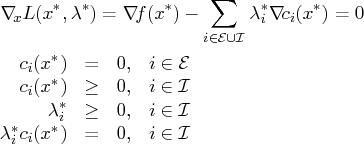| The NLPC Nonlinear Optimization Solver |
Conditions of Optimality
To facilitate discussion of the optimality conditions, we rewrite the general form of
nonlinear optimization problems from the section "Overview" by grouping the equality
constraints and inequality constraints. We also rewrite all the general nonlinear
inequality constraints and bound constraints in one form as ``![]() '' inequality
constraints. Thus we have the following formulation:
'' inequality
constraints. Thus we have the following formulation:
A point ![]() is feasible if it satisfies all the constraints
is feasible if it satisfies all the constraints ![]() and
and ![]() .
The feasible region
.
The feasible region ![]() consists of all the feasible points. In unconstrained
cases, the feasible region
consists of all the feasible points. In unconstrained
cases, the feasible region ![]() is the entire
is the entire ![]() space.
space.
A feasible point ![]() is a local solution of the problem if there exists a
neighborhood
is a local solution of the problem if there exists a
neighborhood ![]() of
of ![]() such that
such that
All the algorithms in the NLPC solver find a local solution of an optimization problem.
Unconstrained Optimization
The following conditions hold true for unconstrained optimization problems:- First-order necessary conditions: If
 is a local solution and
is a local solution and  is continuously differentiable in some neighborhood of
is continuously differentiable in some neighborhood of  , then
, then
- Second-order necessary conditions: If
 is a local solution and
is a local solution and
 is twice continuously differentiable in some neighborhood of
is twice continuously differentiable in some neighborhood of  , then
, then
 is positive semidefinite.
is positive semidefinite.
- Second-order sufficient conditions: If
 is twice continuously
differentiable in some neighborhood of
is twice continuously
differentiable in some neighborhood of  ,
,  , and
, and
 is positive definite, then
is positive definite, then  is a strict local solution.
is a strict local solution.
Constrained Optimization
For constrained optimization problems, the Lagrangian function is defined as follows:We also need the following definition before we can state the first-order and second-order necessary conditions:
- Linear independence constraint qualification and regular point: A point
 is said to satisfy the linear independence constraint qualification if the
gradients of active constraints
is said to satisfy the linear independence constraint qualification if the
gradients of active constraints
 as a regular
point .
as a regular
point .
We now state the theorems that are essential in the analysis and design of algorithms for constrained optimization:
- First-order necessary conditions: Suppose that
 is a local minimum
and also a regular point. If
is a local minimum
and also a regular point. If  and
and  , are
continuously differentiable, there exist Lagrange multipliers
, are
continuously differentiable, there exist Lagrange multipliers  such that the following conditions hold:
such that the following conditions hold:
- Second-order necessary conditions: Suppose
 is a local minimum
and also a regular point. Let
is a local minimum
and also a regular point. Let  be the Lagrange multipliers that satisfy
the KKT conditions. If
be the Lagrange multipliers that satisfy
the KKT conditions. If  and
and  , are twice
continuously differentiable, the following conditions hold:
, are twice
continuously differentiable, the following conditions hold:
 that satisfy
that satisfy
- Second-order sufficient conditions: Suppose there exist a point
 and
some Lagrange multipliers
and
some Lagrange multipliers  such that the KKT conditions are satisfied. If
the conditions
such that the KKT conditions are satisfied. If
the conditions
 that satisfy
that satisfy
 is a strict local solution.
is a strict local solution.
Note that the set of all such ![]() 's forms the null space of the matrix
's forms the null space of the matrix
![]() . Hence we can search for strict
local solutions by numerically checking the Hessian of the Lagrangian function projected
onto the null space. For a rigorous treatment of the optimality conditions, see
Fletcher (1987) and Nocedal and Wright (1999).
. Hence we can search for strict
local solutions by numerically checking the Hessian of the Lagrangian function projected
onto the null space. For a rigorous treatment of the optimality conditions, see
Fletcher (1987) and Nocedal and Wright (1999).
Copyright © 2008 by SAS Institute Inc., Cary, NC, USA. All rights reserved.

